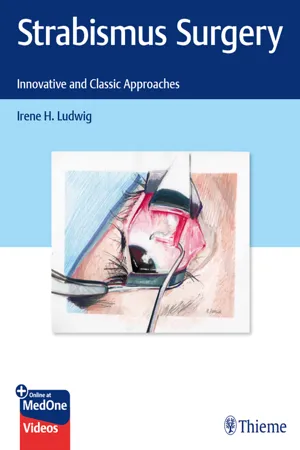
- 334 pages
- English
- PDF
- Available on iOS & Android
About this book
A unique how-to guide on surgical management of strabismus from top experts in the field!
Strabismus correction is the third most common ophthalmic surgery in the US, with 1.2 million procedures performed each year. Strabismus Surgery: Innovative and Classic Approaches by renowned pediatric ophthalmologist Irene H. Ludwig provides comprehensive coverage of strabismus treatment – featuring state-of-the-art techniques based on recent anatomical research and discoveries. Throughout the text and accompanying videos, an impressive group of contributors share clinical pearls and firsthand knowledge.
Recent research shows that strabismus has a mechanical etiology more frequently than previously thought, and that by directly correcting the mechanical defects, more targeted correction is possible than with traditional approaches. Accordingly, the book is organized by mechanism rather than strabismic deviations and patterns. Presented in four parts, each of which is further delineated by sections, this unique textbook includes 36 chapters starting with the fascinating history of strabismus surgery and concluding with future possible treatments.
Key Highlights
- New surgical techniques designed to correct muscle displacements and muscle defects related to abnormalities of the extraocular muscle pulleys and intermuscular bands
- Recognition and repair of stretched scar and flap tear
- A section dedicated to CNS-related causes of strabismus discusses state-of-the-art surgical approaches for conditions including nystagmus and cranial nerve palsies
- A comprehensive summary of injection techniques using botulinum toxin and bupivacaine to correct strabismus, particularly in otherwise inoperable conditions
- Over ninety strabismus surgery videos demonstrate a full spectrum of basic to advanced techniques
- Remarkable illustrations beautifully capture the complex anatomy of the eye muscles and pulleys
The mechanistic approaches described in this outstanding resource will help trainees and seasoned ophthalmologists achieve more precise and lasting results.
Frequently asked questions
- Essential is ideal for learners and professionals who enjoy exploring a wide range of subjects. Access the Essential Library with 800,000+ trusted titles and best-sellers across business, personal growth, and the humanities. Includes unlimited reading time and Standard Read Aloud voice.
- Complete: Perfect for advanced learners and researchers needing full, unrestricted access. Unlock 1.4M+ books across hundreds of subjects, including academic and specialized titles. The Complete Plan also includes advanced features like Premium Read Aloud and Research Assistant.
Please note we cannot support devices running on iOS 13 and Android 7 or earlier. Learn more about using the app.
Information
Table of contents
- Strabismus Surgery: Innovative and Classic Approaches
- MedOne Access Information
- Title Page
- Copyright
- Contents
- Videos
- Foreword
- Preface
- Dedication and Acknowledgments
- My Search for Relief from Double Vision
- Editor’s Discussion of Mr. Watson’s Essay
- Contributors
- Part I Introduction
- Part II Strabismus Diagnosis and Surgical Planning
- Part III Surgical Techniques
- Part IV Conclusion
- Appendix A: Neurological and Neuro/Genetic Disorders
- Appendix B: Patterns by Chapter
- Index
- Additional MedOne Access Information